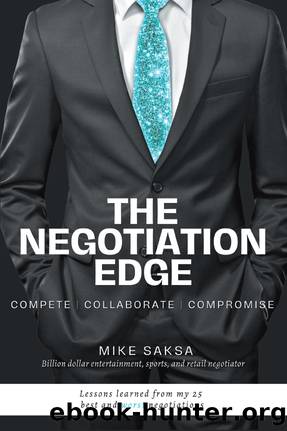The Negotiation Edge by Michael Saksa

Author:Michael Saksa [Michael Saksa]
Language: eng
Format: epub
Publisher: Business Expert Press
Published: 2024-02-22T00:00:00+00:00
The Wal-Mart Negotiating Edge
Every new Wal-Mart vendor starts with the optimism of being in 4,000 stores, which creates the expectations of selling millions of dollarsâ worth of goods. The optimism increases when the Wal-Mart buyer opens the meeting by saying: âOver 110 million shoppers enter our stores each weekâ and âWe just want to be good partners.â These two statements start every meeting like the national anthem at sporting events. The meetings have the constant drum beat request for lower prices, more promotional money, and the subtle threat of returning your inventory. The senior buyer at the close of the meeting will say, âYou tell us when we are not being good partners.â You can tell them what they need to do better, but the discussion will always circle back to you providing a lower price. Failure to improve sales quickly (i.e., lower your price) will have your inventory returned. Wal-Mart will always be a good partner but only when your product outsells your competition.
When negotiating with Wal-Mart, it is best to protect your downside and cautiously pursue your upside. Avoid the error of believing your product will sell above their forecast. Sales velocity below the Wal-Mart forecast creates an edge as they will methodically leverage you for more money. It starts with Wal-Mart having the final say when your product gets shipped back to your manufacturing facility. When your productâs weekly performance is less than expected, the stores remove the excess inventory from their shelves and place it in the backroom. The product will be shipped to the Wal-Mart distribution center where it issues a credit invoice, plus a charge for shipping and handling.
You can avoid this situation by preemptively lowering your price. Giving Wal-Mart price protection on the existing store inventory to get a lower retail price with the expectation of immediately improving consumer sales. You pay Wal-Mart the difference of the current cost and the new lower cost on all inventory. The price protection payment has no guarantee it will work, but failure to lower the price in a timely manner will initiate the product returns. Your financial analysis will usually lead you to lowering the price to create hope for sales improvement versus no action and taking the return.
You are now in the Wal-Mart quicksand of repeatedly lowering price to prevent a return. You provide them with the lowest price you never knew you had. Eventually you will have to say no and take the returned inventory. In May 2005, Wal-Mart surprised DreamWorks by returning a large amount of Shrek 2 DVD inventory, which hurt the DreamWorks earnings and stock price.
Wal-Mart is willing to help you keep your optimism in check by testing your new product in a six-month, 100-store test. You pay all the costs, including 100 percent product returns. They will not be overly concerned with your order quantities but more focused on getting the lowest cost. If your product sells well, the store count will be slowly expanded, until sales underperform the target. When sales taper off, they will recommend a lower consumer price to improve sales.
Download
This site does not store any files on its server. We only index and link to content provided by other sites. Please contact the content providers to delete copyright contents if any and email us, we'll remove relevant links or contents immediately.
| Ethics | Etiquette |
| Fashion & Image | Health & Stress |
| Motivation & Self-Improvement | Work Life Balance |
| Workplace Culture |
Tools of Titans by Timothy Ferriss(8216)
Change Your Questions, Change Your Life by Marilee Adams(7635)
Deep Work by Cal Newport(6878)
Man-made Catastrophes and Risk Information Concealment by Dmitry Chernov & Didier Sornette(5921)
Playing to Win_ How Strategy Really Works by A.G. Lafley & Roger L. Martin(5916)
Digital Minimalism by Cal Newport;(5663)
Big Magic: Creative Living Beyond Fear by Elizabeth Gilbert(5610)
The Slight Edge by Jeff Olson(5346)
Ego Is the Enemy by Ryan Holiday(5293)
The Motivation Myth by Jeff Haden(5156)
Stone's Rules by Roger Stone(5026)
The Laws of Human Nature by Robert Greene(4996)
Tuesdays with Morrie by Mitch Albom(4688)
Eat That Frog! by Brian Tracy(4433)
Rising Strong by Brene Brown(4377)
Skin in the Game by Nassim Nicholas Taleb(4161)
Bullshit Jobs by David Graeber(4094)
The Money Culture by Michael Lewis(4076)
Skin in the Game: Hidden Asymmetries in Daily Life by Nassim Nicholas Taleb(3929)
